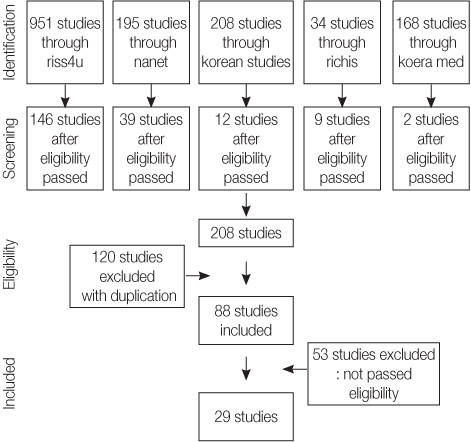J Korean Oncol Nurs.
2011 Feb;11(1):83-92.
A Meta-Analysis of Intervention Studies on Cancer Pain
- Affiliations
-
- 1Eden Adventist Hospital, Namyangju, Korea. ohpj@syu.ac.kr
- 2Department of Nursing, Sahmyook University, Seoul, Korea.
Abstract
- PURPOSE
This study was to analyze the characteristics and effect size of intervention studies in reference to cancer pain.
METHODS
In order to conduct a meta-analysis, a total of 208 studies were retrieved from search engine. And 29 studies published from 2000 to 2010 were selected upon their satisfaction with the inclusion criteria. The data was analyzed by the RevMan 5.0 program of Cochrane library.
RESULTS
1) Intervention studies included 7 studies on reflexology (24.1%), 5 for pain management education (17.2%), 3 studies for each music therapy, spiritual care and hand massage (10.3%, respectively), and 2 studies for each hospice and horticultural therapy (6.7%, respectively). 2) The effect size of the intervention studies were high in hand massage (d=-0.98), reflexology (d=-0.74), spiritual care (d=-0.72), pain management education (d=-0.66), music therapy (d=-0.41), and horticultural therapy (d=-0.32).
CONCLUSION
This study suggest that non-drug therapy can reduce the levels of cancer pain intensity, even though the numbers of intervention studies and randomized controlled trials are very rare.
Keyword
MeSH Terms
Figure
Reference
-
1. Kim YM. The effects of pain management education on pain management concern, analgesic use, and on pain in cancer patients [thesis]. 2009. Gangneung: Kwandong Univ.2. Jo EK. Nurses' knowledge and performance of cancer pain management [thesis]. 2010. Daegu: Keimyung Univ.3. Lee WH. Total pain of patient with terminal cancer. Korean J Hosp Palliat Care. 2002. 3:60–73.4. Chung JS. Effects of spiritual nursing care on spiritual well-being, depression, anxiety and pain in terminal patients with cancer [dissertation]. 2005. Gwangju: Chonnam National Univ.5. Kim EJ, Kyoung BS. The effects of foot reflexology on pain and quality of sleep in patients with terminal cancer. J Korean Clin Nurs Res. 2008. 14:33–44.6. Kim HC. The effect of hospice/palliative care on anxiety and depression, pain in some terminal cancer patients [dissertation]. 2008. Gwangju: Chosun Univ.7. Jang SY. The effects of aroma hand massage on pains, state anxiety and depression in hospice patients with terminal cancer [thesis]. 2008. Daegu: Keimyung Univ.8. Hong MS, Cho MJ. The effects of music therapy on pain, depression and anxiety in terminal cancer patients. J Korean Oncol Nurs. 2010. 10:112–118.9. Song MO. Development and effects of horticultural therapy nursing intervention program for hospice patients [dissertation]. 2010. Daegu: Keimyung Univ.10. Park MH. Understanding and application of evidence based nursing. 2006. Seoul: Goonga publisher.11. Oh PJ. An integrative review of oncology nursing research in Korea: 2003-2008. J Korean Oncol Nurs. 2010. 10:80–87.12. Song HH. Meta-Analysis of medical, nursing, social science study. 2006. Seoul: Chungmoon Publishers.13. Pubmed. accessed on 20 July 2010. Available at: http://www.ncbi.nih.gov/pubmed.14. RISS. accessed on 10 July 2010. Available at: http://www.riss.kr/index.do.15. Library of Congress. accessed on 10 July 2010. Available at: http://www.nanet.go.kr/.16. KISS. accessed on 10 July 2010. Available at: http://kiss.kstudy.com/.17. RICH. accessed on 10 July 2010. Available at: http://www.richis.org/.18. KoreaMed. accessed on 10 July 2010. Available at: http://www.koreamed.org.19. Ezzo J, Richardson MA, Vickers A, Allen C, Dibble S, Issell BF, et al. Acupuncture-point stimulation for chemotherapy-induced nausea or vomiting(review). acessed on 16 April 2010. Available at: http://www.thecochranelibrary.com/view/0/index.html.20. Cochrane. 2010. 04. 16. accessed on 20 July 2010. Arailable at: http://www.cc-ims.net/revman/download.21. Cohen J. Statistical power analysis for the behavioral science. 1988. 2nd ed. New Jersey: Lawrence Erlbaum Associate, Inc.22. Snyder M. Independent Nursing Interventions. 1992. 2nd. NY: Delmar publisher Inc.23. Park SW. Meta-analysis nursing interventions effectiveness for symptom management of cancer patients [thesis]. 2007. Seoul: Korea Univ.24. Kim KH. Development and application of horticultural therapy program using flower color Harmony for the terminal cancer patients [dissertation]. 2008. Daejeon: Paichai Univ.25. Wang MJ, Kim JA, Lee JE, Lee AH, Lee CH, Cha NH. Footcare for health promotion. 2002. Seoul: Hyunmoon Press.26. Kyoung BS. The effectiveness of reflexology on pain, anxiety, quality of sleep in patients with terminal cancer [thesis]. 2006. Daejeon: Daejeon Univ.27. Schulc E, Ecker C, Deufert D, Sandbichler S, Sydow N, Them C. Influence of patient education on pain experience in patients with malignant tumors. Pflege Z. 2008. 61:214–219.28. Rehse B, Pukrop R. Effects of psychological interventions on quality of in adult cancer patients: Meta analysis of 37 published controlled outcome studies. Patient Educ Couns. 2003. 50:179–186.
Article
- Full Text Links
- Actions
-
Cited
- CITED
-
- Close
- Share
- Similar articles
-
- A Meta-analysis of Intervention on Depression in Cancer Patients
- Systematic Review and Meta-analysis in Digestive Cancer Research
- A Meta-Analysis of Intervention Research for Posttraumatic Growth in Cancer Patients
- Theory and Practice of Meta-Analysis
- Effect of Auriculotherapy on Musculoskeletal Pain: A Systematic Review and Meta-Analysis












